Enhanced Magnetic Properties of Co-Doped BiFeO3 Thin Films via Structural Progression
Abstract
1. Introduction
2. Experimental Details
3. Results and Discussion
4. Conclusions
Author Contributions
Funding
Conflicts of Interest
References
- Wu, J.; Fan, Z.; Xiao, D.; Zhu, J.; Wang, J. Multiferroic bismuth ferrite-based materials for multifunctional applications: Ceramic bulks, thin films and nanostructures. Prog. Mater. Sci. 2016, 84, 335–402. [Google Scholar] [CrossRef]
- Eerenstein, W.; Mathur, N.; Scott, J.F. Multiferroic and magnetoelectric materials. Nature 2006, 442, 759–765. [Google Scholar] [CrossRef] [PubMed]
- Spaldin, N.A. MATERIALS SCIENCE: The Renaissance of Magnetoelectric Multiferroics. Science 2005, 309, 391–392. [Google Scholar] [CrossRef] [PubMed]
- Sando, D.; Barthelemy, A.; Bibes, M. BiFeO3 epitaxial thin films and devices: Past, present and future. J. Phys. Condens. Matter 2014, 26, 473201. [Google Scholar] [CrossRef]
- Mukherjee, A.; Basu, S.; Manna, P.K.; Yusuf, S.M.; Pal, M. Giant magnetodielectric and enhanced multiferroic properties of Sm doped bismuth ferrite nanoparticles. J. Mater. Chem. C 2014, 2, 5885–5891. [Google Scholar] [CrossRef]
- Si, Y.-H.; Xia, Y.; Shang, S.-K.; Xiong, X.-B.; Zeng, X.R.; Zhou, J.; Li, Y.-Y. Enhanced Visible Light Driven Photocatalytic Behavior of BiFeO₃/Reduced Graphene Oxide Composites. Nanomaterials 2018, 8, 526. [Google Scholar] [CrossRef]
- Khomchenko, V.A.; Karpinsky, D.V.; Paixão, J.A. Magnetostructural correlations in BiFeO3-based multiferroics. J. Mater. Chem. C 2017, 5, 3623–3629. [Google Scholar] [CrossRef]
- Fujii, K.; Kato, H.; Omoto, K.; Yashima, M.; Chen, J.; Xing, X. Experimental visualization of the Bi–O covalency in ferroelectric bismuth ferrite (BiFeO3) by synchrotron X-ray powder diffraction analysis. Phys. Chem. Chem. Phys. 2013, 15, 6779–6782. [Google Scholar] [CrossRef]
- Mao, W.; Wang, X.; Chu, L.; Zhu, Y.; Wang, Q.; Zhang, J.; Yang, J.; Li, X.; Wei, H. Simultaneous enhancement of magnetic and ferroelectric properties in Dy and Cr co-doped BiFeO3 nanoparticles. Phys. Chem. Chem. Phys. 2016, 18, 6399–6405. [Google Scholar] [CrossRef]
- Dutta, D.P.; Tyagi, A. Effect of Sm3+ and Zr4+ codoping on the magnetic, ferroelectric and magnetodielectric properties of sonochemically synthesized BiFeO3 nanorods. Appl. Surf. Sci. 2018, 450, 429–440. [Google Scholar] [CrossRef]
- Yu, L.; Deng, H.; Zhou, W.; Zhang, Q.; Yang, P.; Chu, J. Effects of (Sm, Mn and Ni) co-doping on structural, optical and magnetic properties of BiFeO3 thin films fabricated by a sol-gel technique. Mater. Lett. 2016, 170, 85–88. [Google Scholar] [CrossRef]
- Gu, Y.; Zhao, J.; Zhang, W.; Zheng, H.; Liu, L.; Chen, W. Structural transformation and multiferroic properties of Sm and Ti co-doped BiFeO3 ceramics with Fe vacancies. Ceram. Int. 2017, 43, 14666–14671. [Google Scholar] [CrossRef]
- Mukherjee, A.; Basu, S.; Green, L.A.W.; Thanh, N.T.K.; Pal, M. Enhanced multiferroic properties of Y and Mn codoped multiferroic BiFeO3 nanoparticles. J. Mater. Sci. 2014, 50, 1891–1900. [Google Scholar] [CrossRef]
- Karpinsky, D.; Troyanchuk, I.O.; Willinger, M.; Khomchenko, V.A.; Salak, A.N.; Sikolenko, V.; Silibin, M.V. Intermediate structural state in Bi1-xPrxFeO3 ceramics at the rhombohedral–orthorhombic phase boundary. J. Mater. Sci. 2017, 52, 9355–9362. [Google Scholar] [CrossRef]
- Chai, Z.; Tan, G.; Yue, Z.; Yang, W.; Guo, M.; Ren, H.; Xia, A.; Xue, M.; Liu, Y.; Lv, L. Ferroelectric properties of BiFeO3 thin films by Sr/Gd/Mn/Co multi-doping. J. Alloys Compd. 2018, 746, 677–687. [Google Scholar] [CrossRef]
- Peng, L.; Deng, H.; Tian, J.; Ren, Q.; Peng, C.; Huang, Z.; Yang, P.; Chu, J. Influence of Co doping on structural, optical and magnetic properties of BiFeO3 films deposited on quartz substrates by sol–gel method. Appl. Surf. Sci. 2013, 268, 146–150. [Google Scholar] [CrossRef]
- Qiu, H.; Chen, G.; Fan, R.; Cheng, C.; Hao, S.; Chen, D.; Yang, C. Tuning the size and shape of colloidal cerium oxide nanocrystals through lanthanide doping. Chem. Commun. 2011, 47, 9648. [Google Scholar] [CrossRef] [PubMed]
- Palewicz, A.; Przeniosło, R.; Sosnowska, I.; Hewat, A.W. Atomic displacements in BiFeO3 as a function of temperature: Neutron diffraction study. Acta Crystallogr. Sect. B Struct. Sci. 2007, 63, 537–544. [Google Scholar] [CrossRef]
- Huang, F.; Wang, Z.; Lu, X.; Zhang, J.; Min, K.; Lin, W.; Ti, R.; Xu, T.; He, J.; Yue, C.; et al. Peculiar magnetism of BiFeO3 nanoparticles with size approaching the period of the spiral spin structure. Sci. Rep. 2013, 3, srep02907. [Google Scholar] [CrossRef]
- Rong, Q.-Y.; Wang, L.-L.; Xiao, W.-Z.; Xu, L. First-principles study of magnetic properties in Co-doped BiFeO3. Phys. B Condens. Matter 2015, 457, 1–4. [Google Scholar] [CrossRef]
- Kim, J.W.; Raghavan, C.M.; Kim, Y.-J.; Oak, J.-J.; Kim, H.J.; Kim, W.-J.; Kim, M.-H.; Song, T.K.; Kim, S. Electrical properties of chemical solution deposited (Bi0.9RE0.1)(Fe0.975Cu0.025)O3−δ (RE=Ho and Tb) thin films. Ceram. Int. 2013, 39, S189–S193. [Google Scholar] [CrossRef]
- Singh, M.K.; Ryu, S.; Jang, H.M. Polarized Raman scattering of multiferroic BiFeO3 thin films with pseudo-tetragonal symmetry. Phys. Rev. B 2005, 72, 132101. [Google Scholar] [CrossRef]
- Yuan, G.L.; Or, D.S.W.; Chan, H.L.W.; Liu, Z.G. Reduced ferroelectric coercivity in multiferroic Bi0.825Nd0.175FeO3 thin film. J. Appl. Phys. 2007, 101, 024106. [Google Scholar] [CrossRef]
- Marzouki, A.; Harzali, H.; Loyau, V.; Gemeiner, P.; Zehani, K.; Dkhil, B.; Bessais, L.; Megriche, A. Large magnetoelectric response and its origin in bulk Co-doped BiFeO3 synthesized by a stirred hydrothermal process. Acta Mater. 2018, 145, 316–321. [Google Scholar] [CrossRef]
- Zhang, Y.; Qi, J.; Wang, Y.; Tian, Y.; Zhang, J.; Hu, T.; Wei, M.; Liu, Y.; Yang, J. Tuning magnetic properties of BiFeO3 thin films by controlling Mn doping concentration. Ceram. Int. 2018, 44, 6054–6061. [Google Scholar] [CrossRef]
- Zhang, Y.; Wang, Y.; Qi, J.; Tian, Y.; Sun, M.; Zhang, J.; Hu, T.; Wei, M.; Liu, Y.; Yang, J. Enhanced Magnetic Properties of BiFeO3 Thin Films by Doping: Analysis of Structure and Morphology. Nanomaterials 2018, 8, 711. [Google Scholar] [CrossRef]
- Liu, Y.; Qi, J.; Zhang, Y.; Wang, Y.; Feng, M.; Zhang, J.; Wei, M.; Yang, J. Surface agglomeration is beneficial for release of magnetic property via research of rare earth (RE) element-substitution. Appl. Surf. Sci. 2018, 427, 745–752. [Google Scholar] [CrossRef]
- Qi, J.; Zhang, Y.; Wang, Y.; Liu, Y.; Wei, M.; Zhang, J.; Feng, M.; Yang, J. Effect of Cr doping on the phase structure, surface appearance and magnetic property of BiFeO3 thin films prepared via sol–gel technology. J. Mater. Sci. Mater. Electron. 2017, 28, 17490–17498. [Google Scholar] [CrossRef]
- Yamashita, T.; Hayes, P.C. Analysis of XPS spectra of Fe2+ and Fe3+ ions in oxide materials. Appl. Surf. Sci. 2008, 254, 2441–2449. [Google Scholar] [CrossRef]
- Sahni, M.; Mukaherjee, S.; Hamid, A.; Kumar, D.; Chauhan, S.; Kumar, N. Structural, optical, magnetic, dielectric, and photocatalytic properties of Sm- and Ni-substituted BiFeO3 nanoparticles. J. Mater. Sci. Mater. Electron. 2020, 31, 7798–7810. [Google Scholar] [CrossRef]
- Sinha, A.; Bhushan, B.; Jagannath; Gupta, N.; Sen, S.; Prajapat, C.; Nuwad, J.; Bhatt, P.; Mishra, S.; Meena, S.; et al. Effect of cobalt-doping on dielectric, magnetic and optical properties of BiFeO3 nanocrystals synthesized by sol–gel technique. Solid State Sci. 2020, 102, 106168. [Google Scholar] [CrossRef]
- Zhang, Y.; Wang, Y.; Qi, J.; Tian, Y.; Zhang, J.; Wei, M.; Liu, Y.; Yang, J. Structural, magnetic and impedance spectroscopy properties of Ho3+ modified BiFeO3 multiferroic thin film. J. Mater. Sci. Mater. Electron. 2019, 30, 2942–2952. [Google Scholar] [CrossRef]
- Wang, J.; Gao, R.; Zhou, D.; Chen, Z.; Wu, Z.; Schumacher, G.; Hu, Z.; Liu, X. Boosting the Electrocatalytic Activity of Co3O4 Nanosheets for a Li-O2 Battery through Modulating Inner Oxygen Vacancy and Exterior Co3+/Co2+ Ratio. ACS Catal. 2017, 7, 6533–6541. [Google Scholar] [CrossRef]
- Wang, J.J.; Hu, J.M.; Yang, T.N.; Feng, M.; Zhang, J.X.; Chen, L.Q.; Nan, C.-W. Effect of strain on voltage-controlled magnetism in BiFeO3-based heterostructures. Sci. Rep. 2014, 4, 4553. [Google Scholar] [CrossRef] [PubMed]
- Neaton, J.B.; Ederer, C.; Waghmare, U.V.; Spaldin, N.A.; Rabe, K.M. First-principles study of spontaneous polarization in multiferroicBiFeO3. Phys. Rev. B 2005, 71, 014113. [Google Scholar] [CrossRef]
- Islam, R.; Islam, S.; Zubair, M.; Usama, H.M.; Azam, S.; Sharif, A. Evidence of superparamagnetism and improved electrical properties in Ba and Ta co-doped BiFeO3 ceramics. J. Alloys Compd. 2018, 735, 2584–2596. [Google Scholar] [CrossRef]
- Carvalho, T.; Manjunath, B.; De La Cruz, J.P.; Amaral, V.; Fernandes, J.; Almeida, A.; Moreira, J.A.; Vilarinho, R.; Tavares, P. Enhancement of resistivity and magnetization of Bi1-xLaxFe1-yMnyO3 ceramics by composition optimization. J. Alloys Compd. 2020, 835, 155404. [Google Scholar] [CrossRef]
- Park, T.-J.; Papaefthymiou, G.C.; Viescas, A.J.; Moodenbaugh, A.; Wong, S.S. Size-Dependent Magnetic Properties of Single-Crystalline Multiferroic BiFeO3 Nanoparticles. Nano Lett. 2007, 7, 766–772. [Google Scholar] [CrossRef]
- Guo, B.; Deng, H.; Zhai, X.; Zhou, W.; Meng, X.; Weng, G.; Chen, S.; Yang, P.; Chu, J. Cr doping-induced structural phase transition, optical tuning and magnetic enhancement in BiFeO3 thin films. Mater. Lett. 2017, 186, 198–201. [Google Scholar] [CrossRef]
- Ruette, B.; Zvyagin, S.; Pyatakov, A.P.; Bush, A.; Li, J.F.; Belotelov, V.I.; Zvezdin, A.; Viehland, D. Magnetic-field-induced phase transition inBiFeO3 observed by high-field electron spin resonance: Cycloidal to homogeneous spin order. Phys. Rev. B 2004, 69, 064114. [Google Scholar] [CrossRef]
- Lin, T.; Chang, H.; Chen, B.; Chang, H.; Wang, C.; Tu, C. Effect of Pr substitution on the structure, nanomechanical and multiferroic characterizations of Bi1-xPrxFeO3 polycrystalline films. Surf. Coat. Technol. 2020, 393, 125728. [Google Scholar] [CrossRef]
- Ravindran, P.; Vidya, R.; Kjekshus, A.; Fjellvåg, H.; Eriksson, O. Theoretical investigation of magnetoelectric behavior in BiFeO3. Phys. Rev. B 2006, 74, 224412. [Google Scholar] [CrossRef]
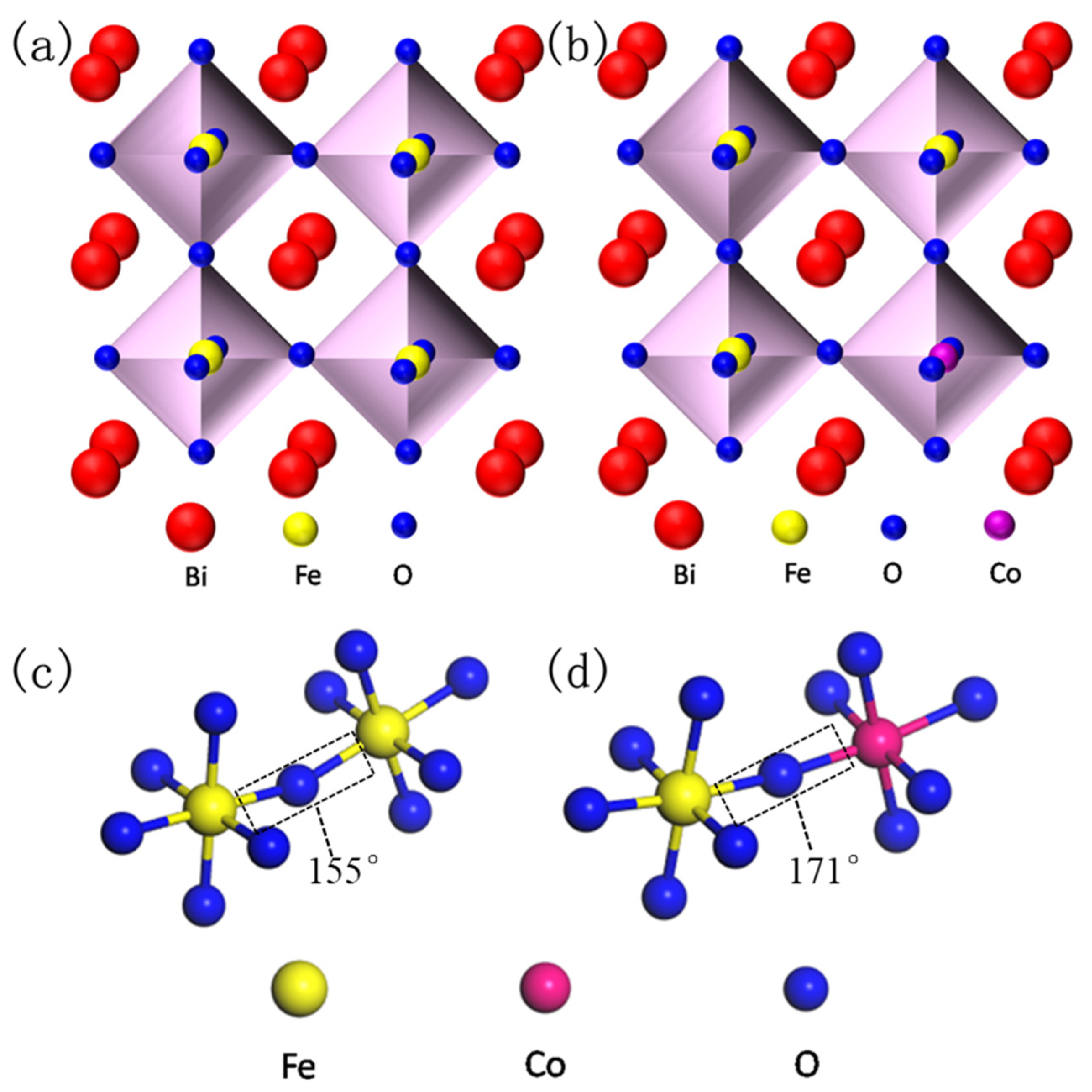
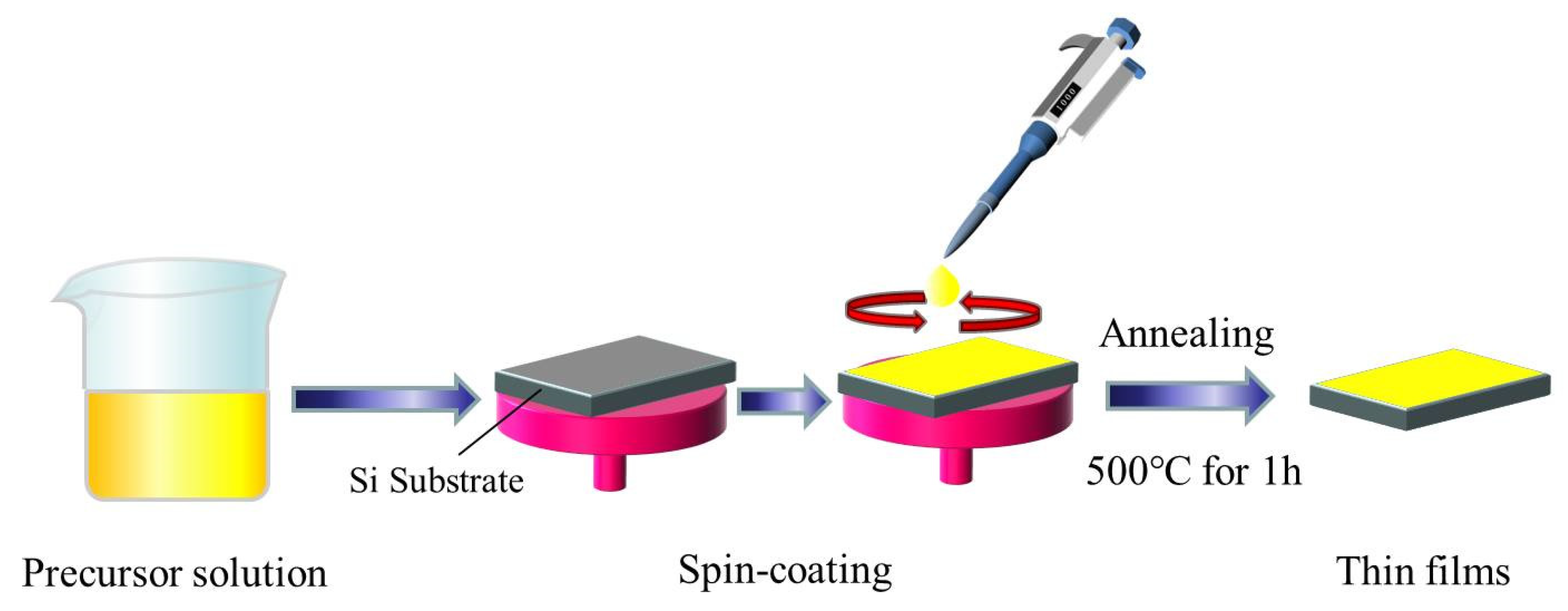
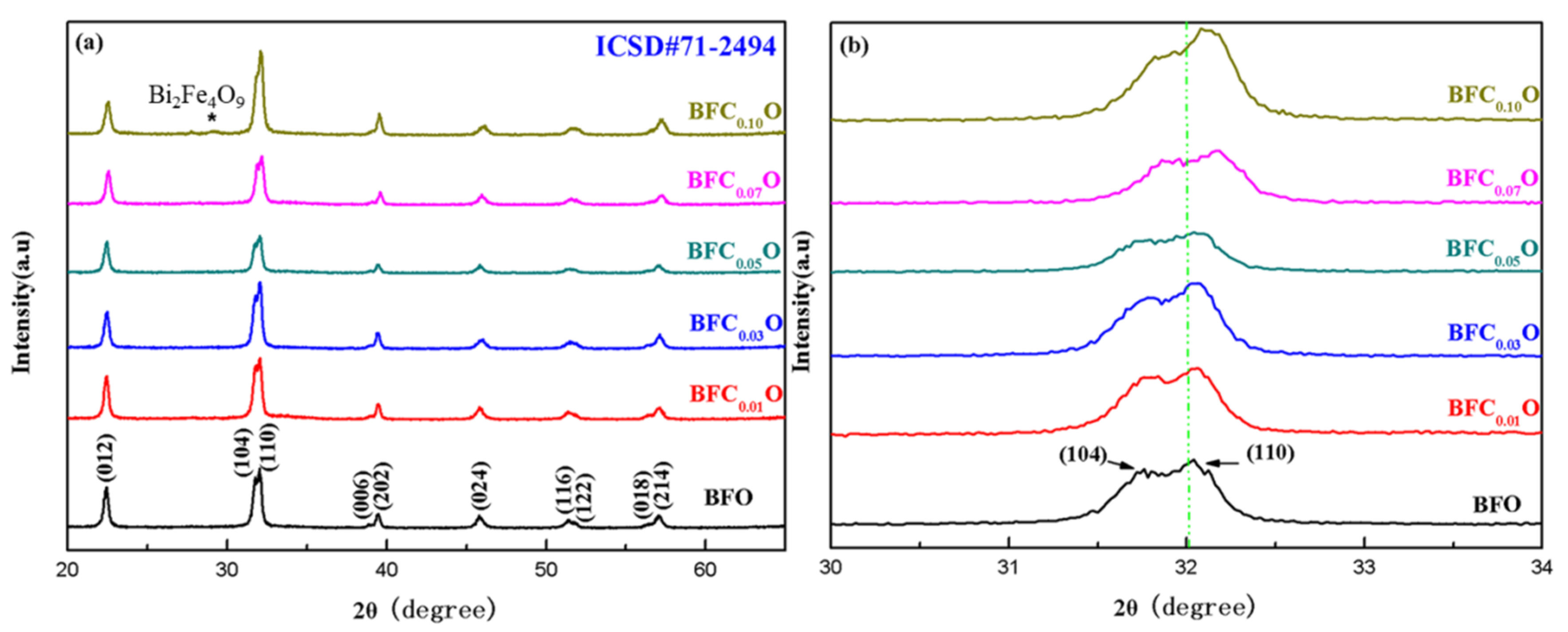
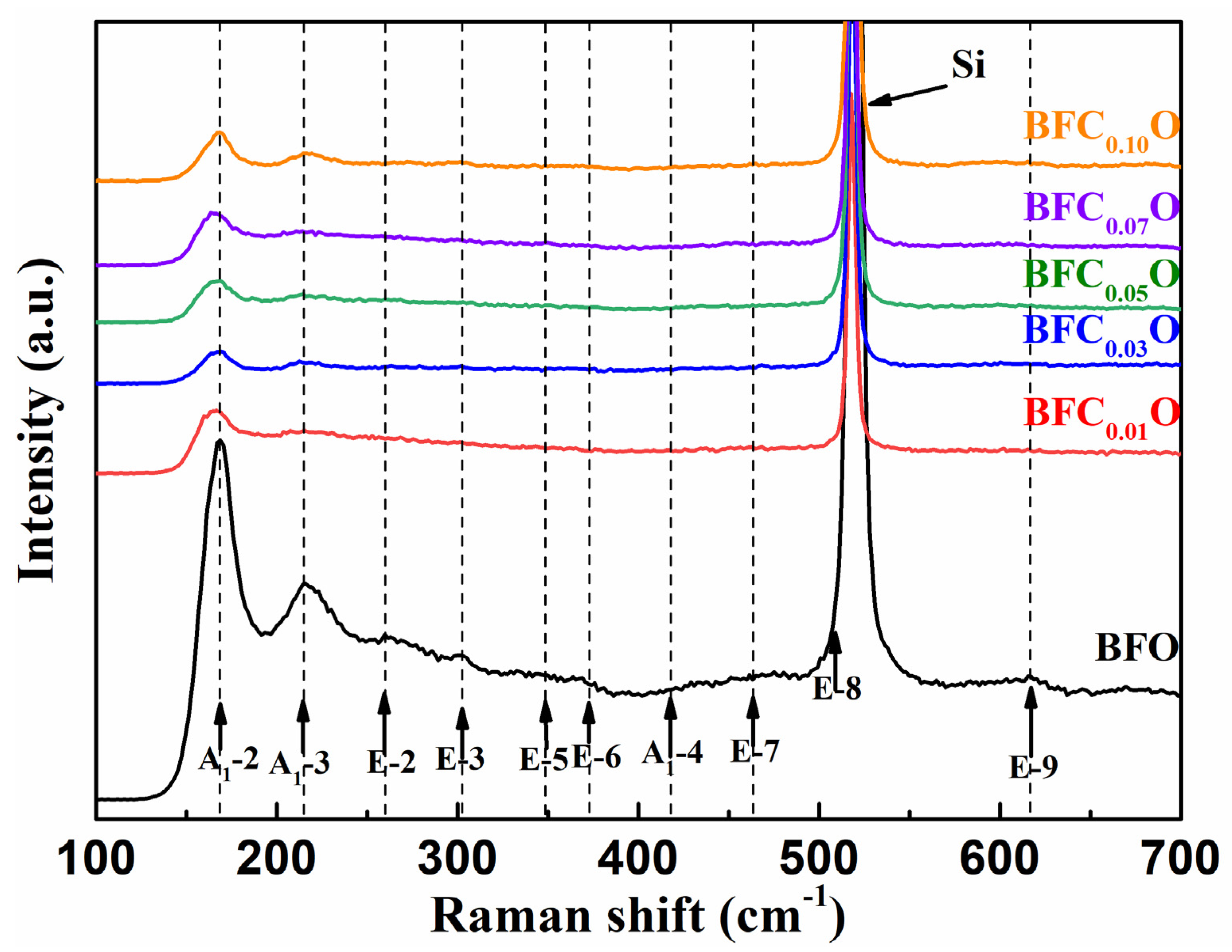
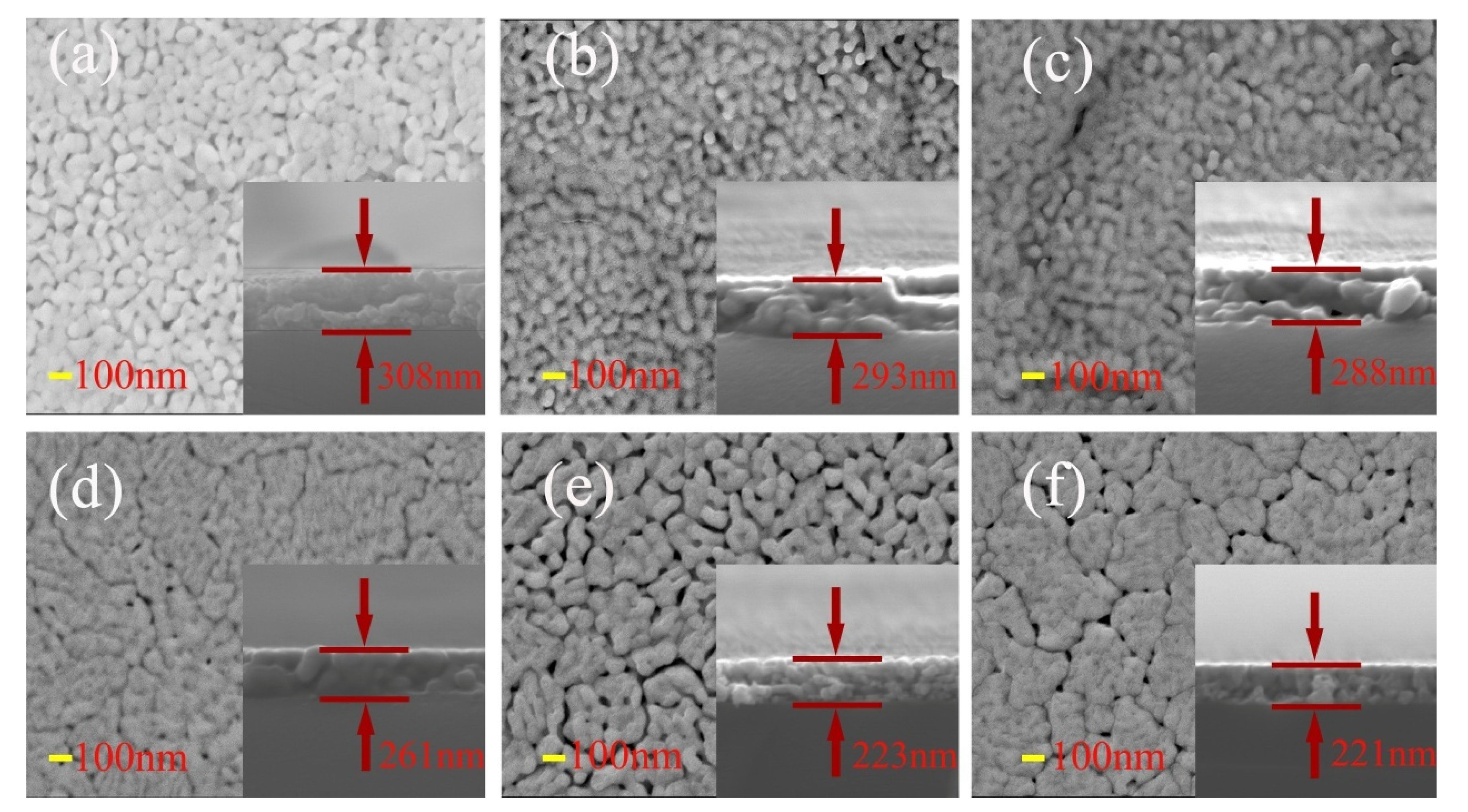
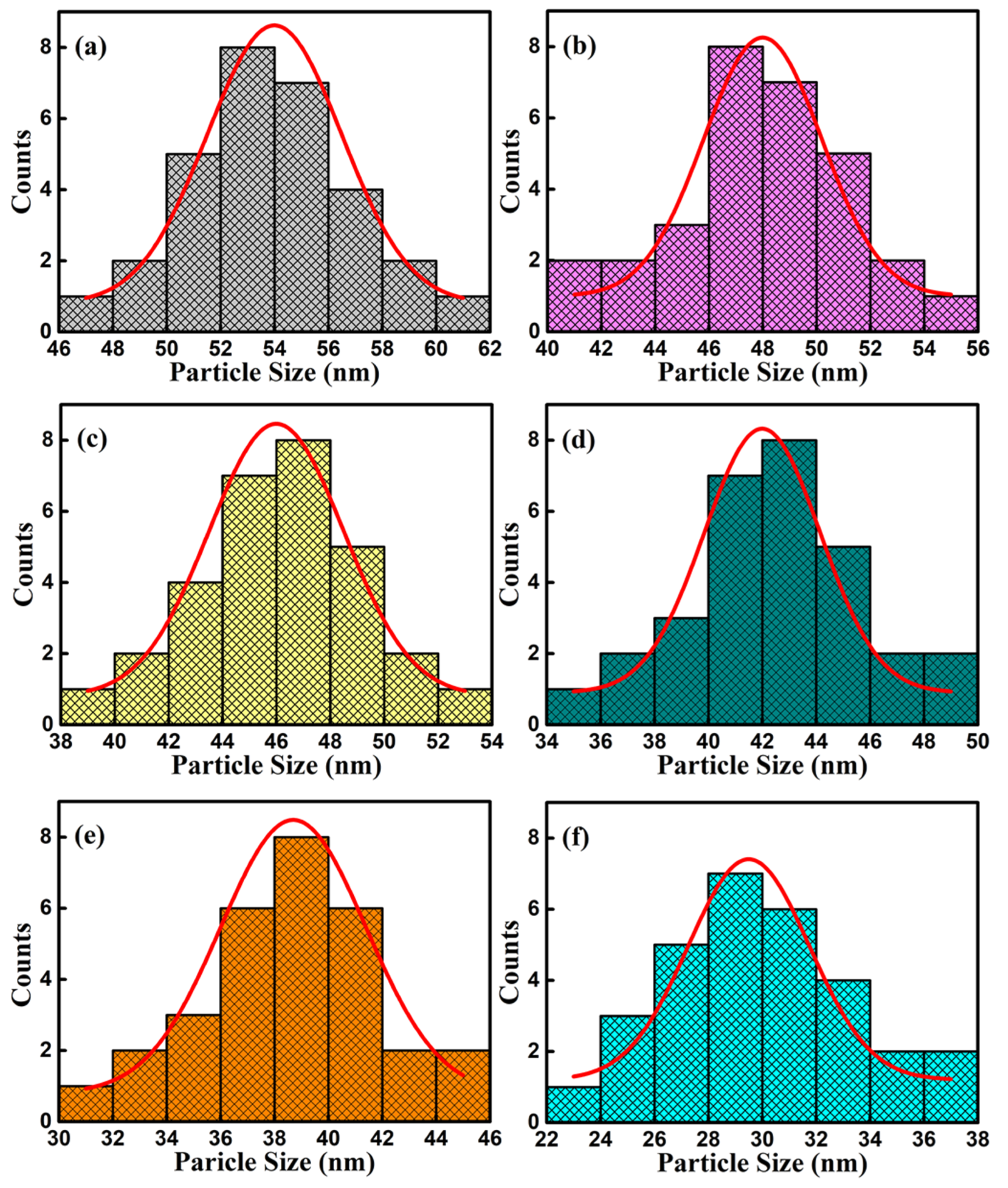
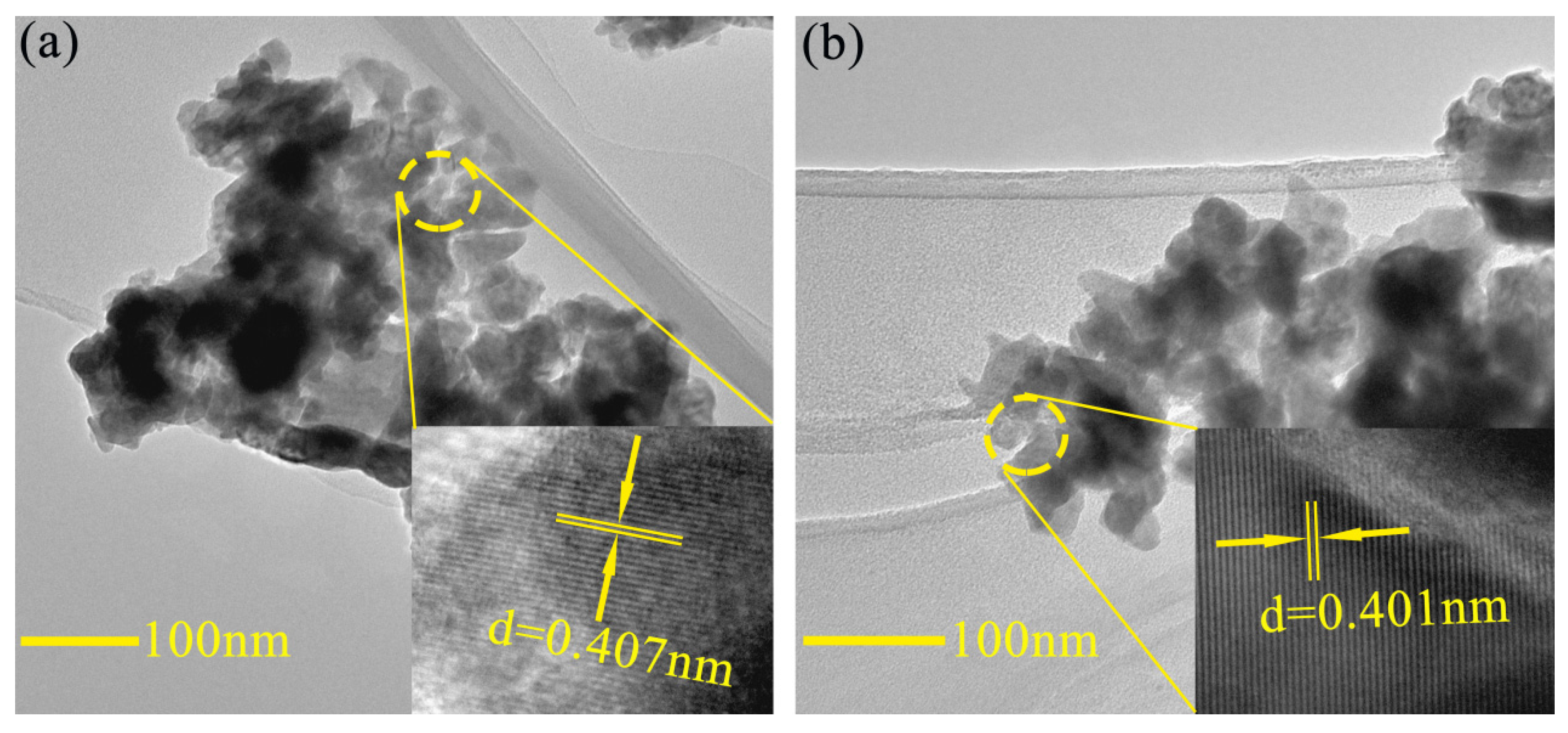
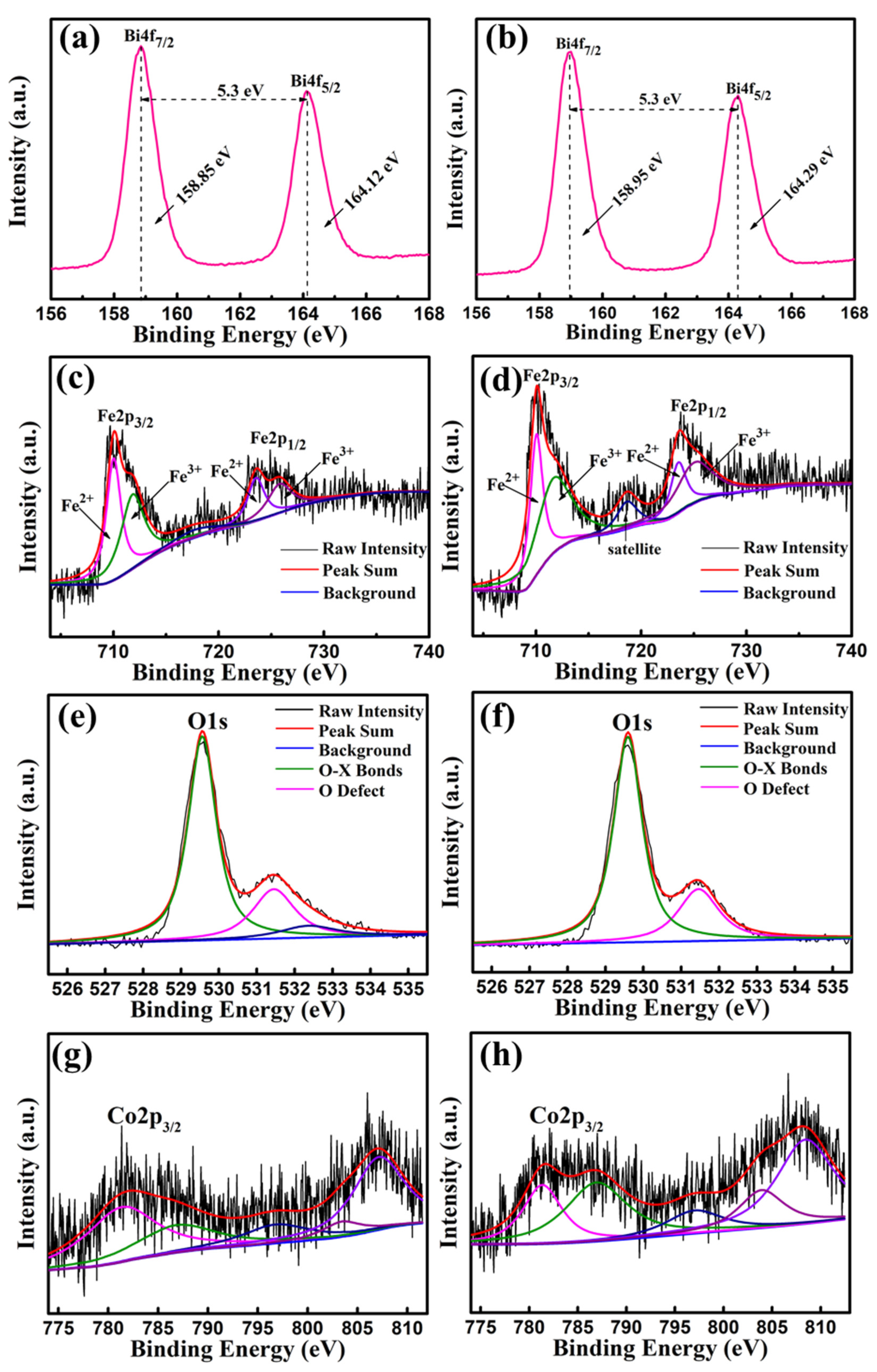
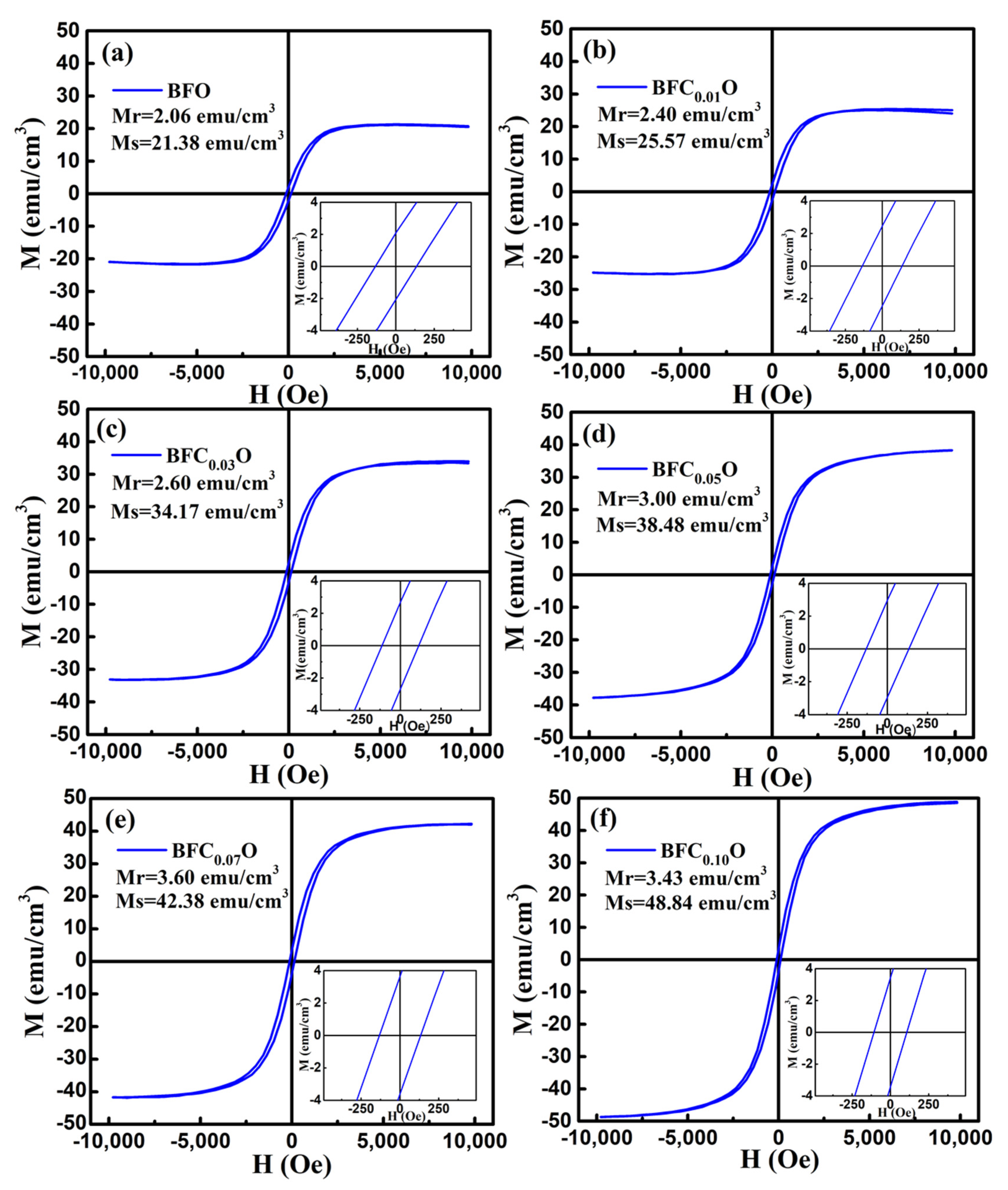

© 2020 by the authors. Licensee MDPI, Basel, Switzerland. This article is an open access article distributed under the terms and conditions of the Creative Commons Attribution (CC BY) license (http://creativecommons.org/licenses/by/4.0/).
Share and Cite
Bai, L.; Sun, M.; Ma, W.; Yang, J.; Zhang, J.; Liu, Y. Enhanced Magnetic Properties of Co-Doped BiFeO3 Thin Films via Structural Progression. Nanomaterials 2020, 10, 1798. https://doi.org/10.3390/nano10091798
Bai L, Sun M, Ma W, Yang J, Zhang J, Liu Y. Enhanced Magnetic Properties of Co-Doped BiFeO3 Thin Films via Structural Progression. Nanomaterials. 2020; 10(9):1798. https://doi.org/10.3390/nano10091798
Chicago/Turabian StyleBai, Liang, Mingjie Sun, Wenjing Ma, Jinghai Yang, Junkai Zhang, and Yanqing Liu. 2020. "Enhanced Magnetic Properties of Co-Doped BiFeO3 Thin Films via Structural Progression" Nanomaterials 10, no. 9: 1798. https://doi.org/10.3390/nano10091798
APA StyleBai, L., Sun, M., Ma, W., Yang, J., Zhang, J., & Liu, Y. (2020). Enhanced Magnetic Properties of Co-Doped BiFeO3 Thin Films via Structural Progression. Nanomaterials, 10(9), 1798. https://doi.org/10.3390/nano10091798




